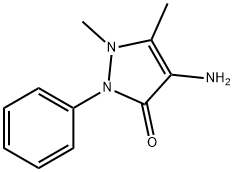- 4-Aminoantipyrine
-

- $0.00 / 1g
-
2025-04-16
- CAS:83-07-8
- Min. Order: 1g
- Purity: 98.0%
- Supply Ability: 10kg/month
- 4-Aminoantipyrine
-

- $0.00 / 1KG
-
2025-04-15
- CAS:83-07-8
- Min. Order: 1KG
- Purity: 99%
- Supply Ability: 500000kg
- 4-Aminoantipyrine
-

- $128.00 / 25KG
-
2025-03-26
- CAS:83-07-8
- Min. Order: 25KG
- Purity: 98%
- Supply Ability: 1-1000kg
|
| | 4-Aminoantipyrine Basic information |
| Product Name: | 4-Aminoantipyrine | | Synonyms: | 4-Amine-2,3-dimethyl-lphenyl-5-pyrazolone-[5],Ampyrone;4-amino-1,2-dihydro-1,5-dimethyl-2-phenyl-3h-pyrazol-3-on;AKOS BBS-00007964;AMINOANTIPYRINE, 4-;AMINOANTIPYRINE REAGENT;AMINOPHENYZONE;1-PHENYL-2,3-DIMETHYL-4-AMINOPYRAZOLONE;1,5-DIMETHYL-2-PHENYL-4-AMINOPYRAZOLONE | | CAS: | 83-07-8 | | MF: | C11H13N3O | | MW: | 203.24 | | EINECS: | 201-452-3 | | Product Categories: | PYRAMIDON;Heterocycles, Metabolites & Impurities, Pharmaceuticals, Intermediates & Fine Chemicals;reagent;Heterocycles;Intermediates & Fine Chemicals;Metabolites & Impurities;Pharmaceuticals;Drug bulk;Antibiotic Explorer;Pyridines, Pyrimidines, Purines and Pteredines | | Mol File: | 83-07-8.mol |  |
| | 4-Aminoantipyrine Chemical Properties |
| Melting point | 105-110 °C(lit.) | | Boiling point | 340 C | | density | 0.8 | | bulk density | 430kg/m3 | | refractive index | 1.4930 (estimate) | | storage temp. | Keep in dark place,Inert atmosphere,Room temperature | | solubility | H2O: 0.1 g/mL, clear | | pka | pK1: 4.94(+1) (25°C) | | form | Powder or Crystals | | color | Yellow to yellow-brown | | PH | 7.1 (100g/l, H2O, 20℃)(slurry) | | Odor | Odorless | | Water Solubility | ca. 500 g/L (20 ºC) | | Merck | 14,591 | | BRN | 181635 | | Stability: | Stable. May be light sensitive. | | LogP | -0.257 (est) | | CAS DataBase Reference | 83-07-8(CAS DataBase Reference) | | NIST Chemistry Reference | Aminoantipyrene(83-07-8) | | EPA Substance Registry System | 4-Aminoantipyrene (83-07-8) |
| | 4-Aminoantipyrine Usage And Synthesis |
| Chemical Properties | Amber crystalline powder | | Application | 4-aminoantipyrine is the most widely used analytical reagent for the estimation of phenol. It is used as a reagent for glucose determination in the presence of peroxidase and phenol. It is also used as indicator for trace phenol determinations in water.
Phenolic compounds were determined by buffering the sample to a pH of 10.0 and adding 4-aminoantipyrine to produce a yellow or amber colored complex in the presence of ferricyanide ion. The colour is intensified through extraction of the complex into chloroform. Measurement of this colour quantitatively determines the phenol concentration of the sample. | | Uses | 4-Aminoantipyrine is a metabolite of aminopyrine, having both analgesic and anti-inflammatory properties. It readily forms metal complexes due to its amino nitrogen, a strong coordination site.
4-aminoantipyrine forms Schiff bases when treated with aldehydes/ketones, which are used in chemosensing applications.
Coupling Reagent for Trinder's reagent in colorimetric hydrogen peroxide detectionassays.
Forms highly stable dyes by coupling with Trinder's reagent in presence of Peroxidase and H2O2. Therefore suitable for use in test strip and solution diagnostics. | | Preparation | synthesis of 4-aminoantipyrine: Antipyrine is nitrosated by sodium nitrite, reduced by ammonium bisulfite and ammonium sulfite, hydrolyzed by sulfuric acid, and finally neutralized with liquid ammonia to obtain 4-aminoantipyrine. | | Definition | ChEBI: 4-aminoantipyrine is a pyrazolone, a member of the class of pyrazoles that is antipyrine substituted at C-4 by an amino group. It is a metabolite of aminopyrine and of metamizole. It has a role as a non-steroidal anti-inflammatory drug, a non-narcotic analgesic, an antirheumatic drug, a peripheral nervous system drug, an EC 1.14.99.1 (prostaglandin-endoperoxide synthase) inhibitor, an antipyretic, a drug metabolite and a marine xenobiotic metabolite. It is a primary amino compound and a pyrazolone. It derives from an antipyrine. | | General Description | 4-Aminoantipyrine forms heterocyclic Schiff bases, by reaction with various aldehydes and oximes. These Schiff bases form stable complexes with transition metals. | | Purification Methods | It crystallises from EtOH or EtOH/ether. [Beilstein 25 III/IV 3554.] |
| | 4-Aminoantipyrine Preparation Products And Raw materials |
| Raw materials | Sulfuric acid-->Sodium nitrite-->Ammonium bisulfite-->Antipyrine-->Starch paper-->2,3-dimethyl-4-nitroso-1-phenyl-3-pyrazolin-5-one | | Preparation Products | Aminopyrine-->1,2-dihydro-1,5-dimethyl-4-(methylamino)-2-phenyl-3H-pyrazol-3-one-->AMMONIUM ALGINATE-->N-(2,3-dihydro-1,5-dimethyl-3-oxo-2-phenyl-1H-pyrazol-4-yl)formamide-->Ramifenazone-->N-(1,5-dimethyl-3-oxo-2-phenylpyrazol-4-yl)-3-methoxybenzamide-->2-CYANO-N-(1,5-DIMETHYL-3-OXO-2-PHENYL-2,3-DIHYDRO-1H-PYRAZOL-4-YL)-ACETAMIDE-->3-CHLORO-N-(1,5-DIMETHYL-3-OXO-2-PHENYL-2,3-DIHYDRO-1H-PYRAZOL-4-YL)PROPANAMIDE-->AMINOPROPYLON |
|